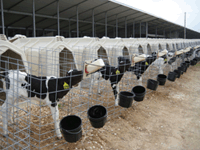When calves get sick, producers tend to focus on the technical issues, but often times, it can be everyday details that lead to calf health challenges.

Bethany Fisher and Christie Underwood, calf and heifer specialists with Purina Animal Nutrition LLC share insights on areas that can be overlooked.
Dip navels immediately after birth
Navel dipping equipment should be sanitized on a regular basis, as dipping a navel with dirty disinfectant defeats the purpose all together. If present in high quantities, organic matter can overcome the disinfectant.
Fisher advises calf managers to evaluate their navel dipping practices with these questions:
How often is the disinfectant changed out?
Are navel dippers being regularly cleaned?
If navels are being clipped, are the scissors being sanitized between uses? Sanitizing with Nolvasan® is recommended.

"The navel acts as a highway to the bloodstream," says Fisher.
Clean and sanitize colostrum feeding equipment
Colostrum management is one of the most important areas of focus when it comes to cleanliness. "If basic sanitation efforts are not adhered to, unsanitized esophageal feeders, bottles and nipples can serve as direct pathways for undesirable bacteria into the calf," Underwood says.
Any crack, crease, or crevice can harbor harmful bacteria despite even the most thorough of cleaning practices. Underwood suggests calf managers evaluate the cleanliness of calf feeding equipment with these basic questions:
Is feeding equipment cleaned according to protocol?

Is feeding equipment allowed to completely dry between uses?
Are there scratches in plastic or small spaces that are hard to clean?
Are bottles greasy?
Are feeding nipples old and cracked?
Is the water tank/trailer/dispenser being cleaned on a regular basis?
Evaluate cleanliness of maternity pen and transport equipment
Maternity pens, trailers and calf carts can also harbor pathogens that can infect calves before they enter their calf hutch/pen. Fisher highlights some key items to consider before calves are moved to individual hutches/pens:
What kinds of bedding materials are being used in maternity pens?

How often are maternity pens cleaned?
How soon after birth are newborn calves transported?
How often is transport equipment being sanitized?
Sanitize calf hutches
Fisher stresses, once calves are moved from the maternity pen to the hutch or pen they are not yet out of the woods. A calf facility that is not properly sanitized can allow bacteria to be carried on to the next cycle of calves. "It is vital that calf hutches and pens are thoroughly cleaned between calves, especially if the previous calf became sick," says Fisher. Fisher also advises to make sure to sanitize both the walls of the calf housing unit and the ground or area beneath the calf unit.
Evaluate biosecurity policies
Both Fisher and Underwood point out how important biosecurity is on calf operations. Employees and visitors can be unsuspecting sources of calf disease. Anyone who works directly with animals should use latex gloves; this can limit the transfer of harmful pathogens, according to both Fisher and Underwood. Shoes and clothes must also be clean and disinfected before and after people enter a calf facility to minimize the spread of bacteria.
Bacteria can lurk in the most unexpected places and can quickly be transferred from one animal to the next. Having sanitation protocols in place and holding employees accountable for their cleaning practices can help calf operations raise healthy calves that develop into cows with more profit potential.
For more information, contact Bethany Fisher at (870) 830-6999, email BLFisher@landolakes.com; Christie Underwood at (806) 640-8045, email CMUnderwood@landolakes.com or visit www.amplicalf.com.
Purina Animal Nutrition LLC (www.purinamills.com) is a national organization serving producers, animal owners and their families through more than 4,700 local cooperatives, independent dealers and other large retailers across the United States. Driven by an uncompromising commitment to animal excellence, Purina Animal Nutrition is an industry innovator, offering America's leading brands of complete feeds, supplements, premixes, ingredients and specialty technologies for the livestock and lifestyle animal markets. Headquartered in Shoreview, Minn., Purina Animal Nutrition LLC is a wholly owned subsidiary of Land O'Lakes, Inc.
03.01.2013